PermaGarden Workshop
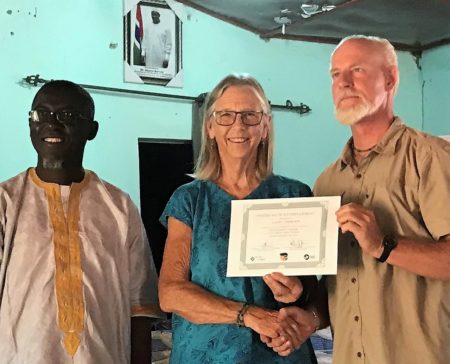
I attended a very informative permagarden workshop at the Jenoi Farmer Training Center, which is just across the river from where I live in Farafenni. This workshop was presented by Peter Jensen, who was sponsored by Water Charity and hosted by Gambia Rising and Peace Corps The Gambia. Peter is an Agroecology and Permagarden Training Specialist, and has spent the last two decades developing the Terra Firma Permagarden method to address the challenges of climate change in the tropics. This method applies gardening techniques to manage excess water in the wet season and the lack of rainwater in the long dry season. By double digging the planting beds, enriching the soil with amendments, creating berms and sinkholes to channel the water, a permagarden will increase the ability of the soil to retain water year round.
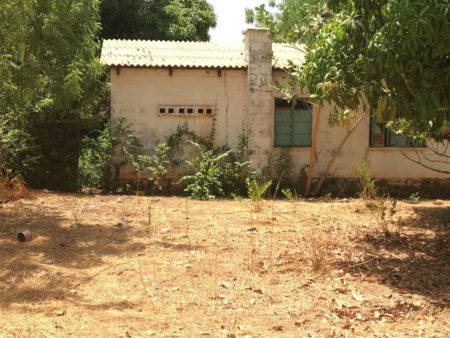
The workshop was attended by seven PCVs and a dozen Gambians. It was amazing to watch the transformation of a plot of land into a permagarden, in just three days of work. People can not change the climate, but we can change the soil to create a better growing environment. This method focuses on using what is locally available and accessible to a farmer. The entire garden can be prepared using just a dabba – a hand held hoe that every Gambian owns. Many times an outside organization has come into a community and created a project that requires expensive resources to maintain. There was an example of this type of project at Jenoi – a large fenced area, with a solar powered water pump. Problems arise when the fence or pump needs repair and there isn’t any money or people to fix them. Additionally, if no attention is given to creating better soil and teaching optimal gardening techniques that will retain water, then the farmer will becomes a slave to constantly watering the plants. A Peace Corps goal is to foster independence, rather than dependency upon outsiders
Peter had several acronyms or catch phrases to describe his philosophy, one is CLOSE: Close – Local – Organic – Small – Easy. Permagardening is a gardening technique that can grow a high quantity of nutrient-rich food in a small space using inexpensive, locally-available resources. The emphasis is placed on growing food where it is convenient to manage, using local plants, seeds, and tools that are readily accessible. In place of expensive chemicals and seeds, using materials that are on hand such as compost, charcoal, leaves, and ashes to augment the soil, it is possible to create a sustainable garden.
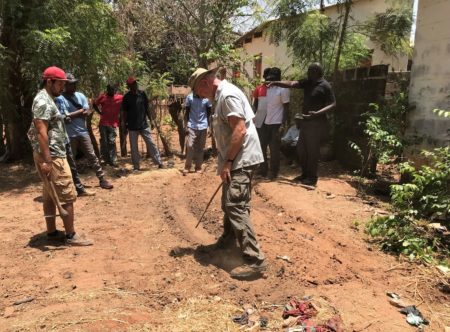
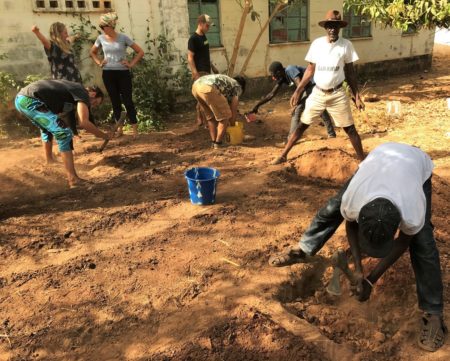
Permagardening means making a garden that will provide produce all year long. This can be very difficult when you live in a climate where it rains heavily for only three months, and then is dry for nine months. Permagardening has features that will help capture and store water from the rainy season, to be available during the dry season. Making use of the water coming off of rooftops is a major component of Peter’s permagarden designs. Locating the garden to take advantage of your roof will add water collection opportunities and place the garden close to your home. Peter’s 6 Success Words: Stop – Slow – Sink – Spread – Save – Shade.
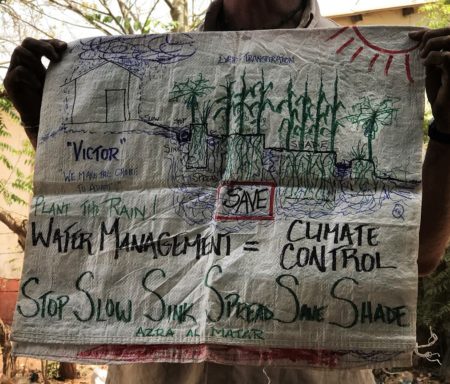
Permagardens address many aspects of food security, but especially access. Many women want to cook more fresh vegetables for healthy meals, but vegetables can be expensive or unavailable for months at a time. The benefit of permagardens is in the creation of good water retaining soil in order to be able to plant food throughout the year. There are three words to remember when focusing on nutritional needs: GO – carbohydrates for energy; GROW – building balanced meals with protein, GLOW – adding vitamins and minerals to provide protection for the body.
View a four minute iPhone video on YouTube demonstrating amending the subsoil layer.
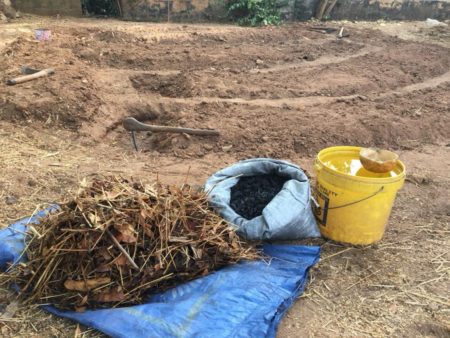
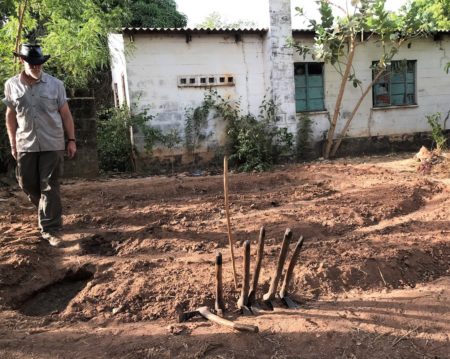
We spent the first day discussing permagarden techniques, preparing the site, and adding amendments to the subsoil. This was a hands on workshop, and Peter had us make a permagarden using the techniques below:
- Garden site selection of locating it next to a roof, and channeling the run off to where it is needed.
- Double digging the soil to break into the hard subsoil, and mixing up the layers as you dig deeply. This will add air to the soil, which allows space for more water.
- Adding compost, charcoal, leaves, manure and ashes into the soil. This will add nutrition for the plants or help store water.
- Triangle spacing of seedlings which allows for planting multiple things together (like beans and corn), and economizes the space. It also gives more room for the plants to grow bigger, and shades the soil for less water evaporation.
- Protective berms will keep the garden beds from eroding. The water will fall off the roof, hit the berm, spread out to infiltrate the garden slowly, and flow into the sinkholes that act as reservoirs, rather than pummeling it all at once.
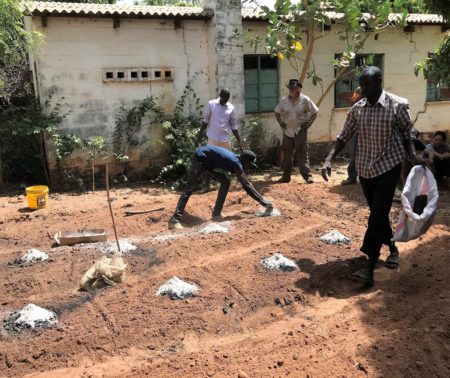
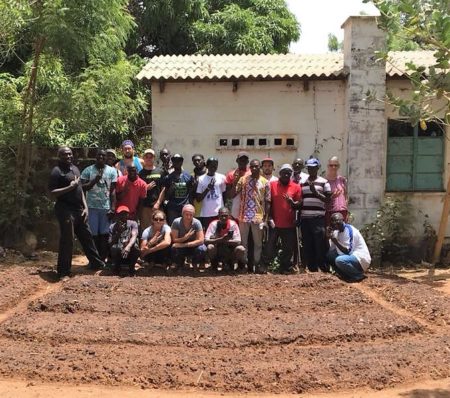
The morning of day two we finished preparing the garden for planting by amending the topsoil, the second dig in the double digging method. Paying attention to retaining the paths, berms and beds to channel the flow of water to the sinkholes and preventing erosion is a critical element for sustainability. After adding charcoal and wood ashes to the topsoil, we lightly watered the beds before lunch.
We returned in the late afternoon to plant our seeds with triangular spacing. Another light watering was applied before adding a layer of dried leaves as mulch, and finishing by sticking neem tree branches into the beds to provide shade. The neem foliage will die back in about a week after the seeds have germinated, and the branches can be removed to the compost pile.
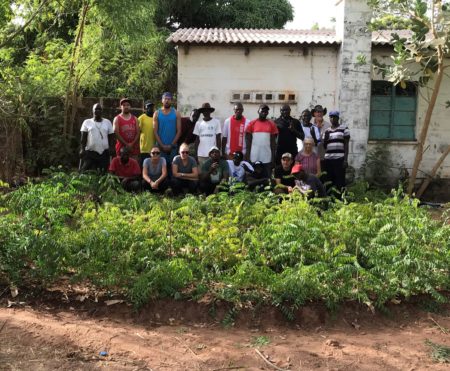
Inspecting the paths, berms and sinkholes regulartly and making repairs will prevent erosion. Permagardens do require maintenance for continued success, but when you don’t have to constantly haul water to the plants, you have time to pay attention to the details, while harvesting healthy foods.
At the beginning of day three, we discussed how to return to our villages and share our new skills with our communities Another catch phrase of Peter’s is: CLIMATE SMART: which is adapting a garden site with beds, berms and sinkholes; while mitigating the effects of climate change by adding carbon to the soil with compost, charcoal and mulch; and intensifying food production with triangular spacing and creating shade in the finished garden.
It is import to start out with small permagardens, so you don’t overwhelm or intimidate a farmer with this new technique. The permagarden can be expanded in the future or additional gardens can be established after this new method is learned.
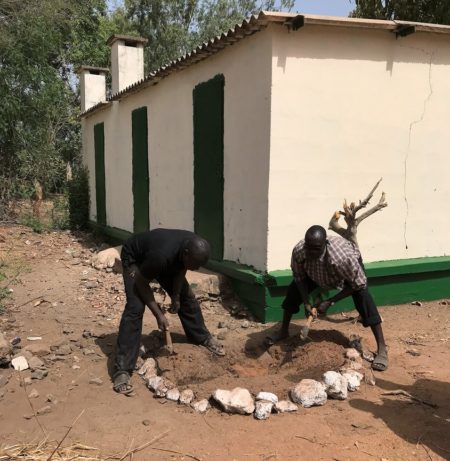
We also walked around the training center looking at areas that could become permagardens, so we will be able to appraise areas in our home communities that would be good garden sites. Finally, Peter presented the concept of keyhole gardens. He envisions using the corners of building to create small gardens that could benefit people living in close proximity to each other, such as refugee camps. Taking advantage of the water coming off the corner of a building to channel it into a small keyhole area with a sinkhole in the center. A double dug bed surrounding the center creates a space to cultivate vegetables. If space allows more planting beds can radiate outward from the center sinkhole for added gardening area. The small is beautiful concept is very appropriate in this situation.
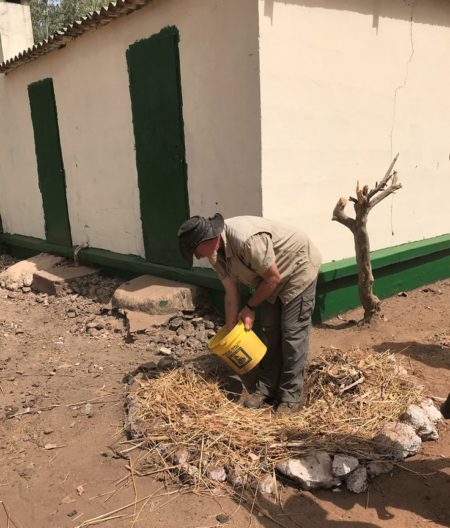
Creating permagardens for empowerment and resilience with small doable actions can produce immediate, measurable and verifiable results. I’ve been gardening for over fifty years and was very impressed with the messages Peter was sharing with us. It’s never too late to teach old gals new tricks.
I hope I can be successful communicating some of these new techniques in my community. If I influence a handful of people by demonstrating new methods, then they will be able to influence others. Peace Corps is all about people to people connections for improving the quality of life in developing communities.
One thought on “PermaGarden Workshop”
That must have been a fascinating workshop. How wonderful to teach techniques that the local people can continue to use within the financial, cultural, and environmental constraints that are present! It sounds a perfect implementation of the Peace Corps mission concept.
The Dallas, Oregon public park has a demonstration project on Hugelkultur (raised beds on wood) that is supposed to retain water by burying wood under the garden bed that then composts underground. I am thinking I might have to give that a try myself.
Comments are closed.